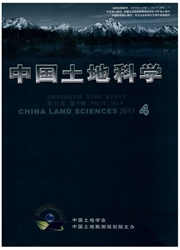

 中文摘要:
中文摘要:
利用景观格局和空间分析方法,以SPOT卫星影像为主要信息源,分析了北京大兴区农村土地利用格局及土地整治方向。结果表明:①该区后备耕地资源贫乏,土地破碎严重,不同地类镶嵌且分散分布,同类土地集聚度较低;②村庄用地总面积大,人均用地极高,斑块数量多,分布均匀,整理潜力和难度大;③设施农用地、园地和设施耕地等集约利用程度较高的农用地比例很大,但规模化程度较低;④畜禽养殖用地离村庄用地和道路太近,且用于消纳畜禽废弃物的农用地不足,防疫和污染风险较高;上述问题表明该区亟需开展土地综合整治,优化用地结构和空间布局。
 英文摘要:
英文摘要:
Using SPOT images as a primary source of information, this paper analyzed the rural land use pattern and its consolidation direction of Daxing district in Beijing by the methods of landscape pattern and spatial analysis. Results showed that: 1) the reserve of cultivated land resource was scarce, and land use type distributed highly scattered with low aggregation; 2) the rural residential land distributed evenly with large total area, high patch number and extremely high per capita land, thus had great consolidation potential and difficulty; 3) nearly half of agricultural lands were relatively intensive used, such as greenhouse land, orchard land and aquaculture land, but the operation scales were low very much; 4) scattered aquaculture lands were very close to residential lands and roads, and short of the agricultural land to consume animal wastes, which leads to high risk on disease spreading and non-point pollution. The above problems showed it urgent to conduct integrated land consolidation, optimize land use structure and spatial layout in the area.
 同期刊论文项目
同期刊论文项目
 同项目期刊论文
同项目期刊论文
 期刊信息
期刊信息
